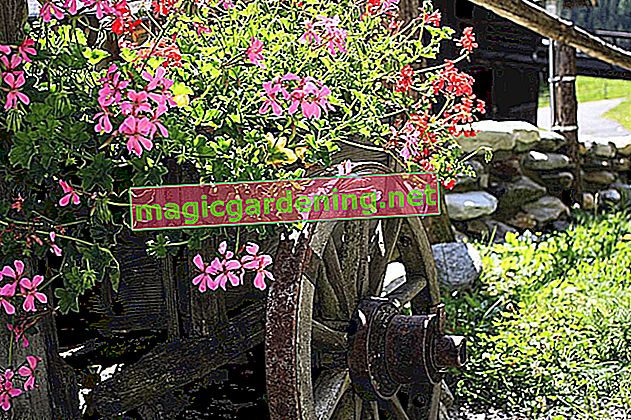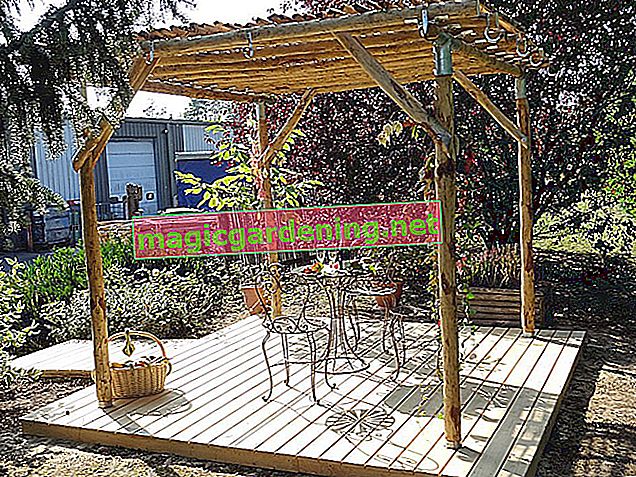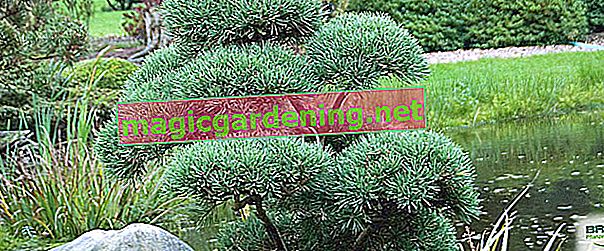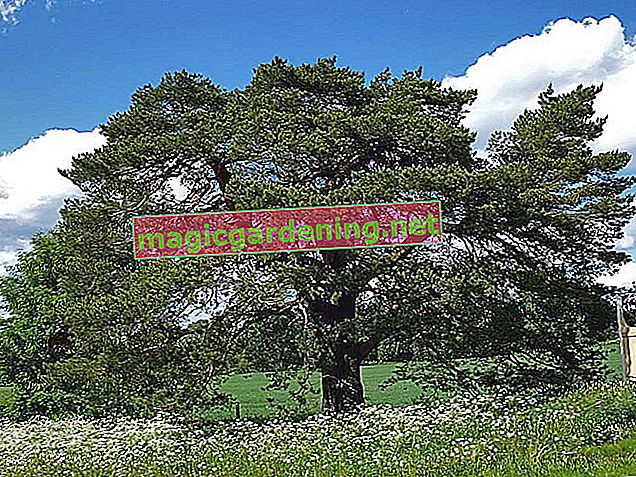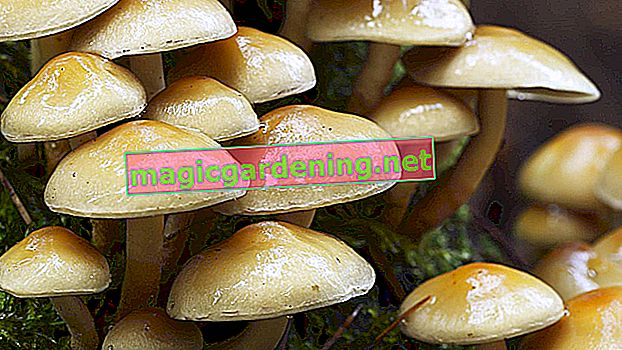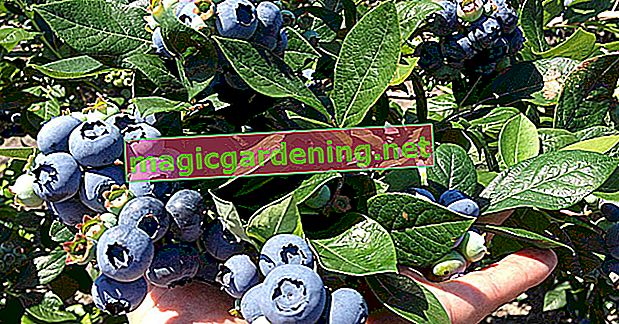
Origin and Distribution
All around 67 known sunflower species are native to both North and Central America from Mexico to Canada, with each variety having its own natural range. The genus of sunflowers (bot. Helianthus) belongs to the sunflower family (bot. Asteraceae) and is particularly popular because of its bright yellow, multi-rayed flower heads.
also read
- These perennial sunflowers are hardy - a selection of varieties
- Hardy and long-lasting: sunflower perennials
- When is the best time to plant sunflowers?
Appearance and stature
Perennial sunflowers form numerous, upright and rather thin stems on which the numerous flowers sit. The height of growth varies depending on the species and variety - while some of the perennial species can reach heights of up to 300 centimeters, others just reach a height of 100 to 120 centimeters. However, the strongly branched and thickened rhizome is typical, from which further shoots sprout in most species. Perennial sunflowers usually grow clumpy and form more or less numerous runners.
use
All types of perennial sunflowers are valuable forage crops for bees and other insects, even if they are often otherwise sterile hybrid breeds. Depending on the height and width of growth, some species are very well suited for area planting, while others are more effective as solitaires. The flowering plants decorate mixed or pure perennial beds or borders, can be used as a border, as a privacy screen or as a planting on the edge of the wood. The bright yellow flowers look particularly distinctive as a background plant in front of other perennials with blue, purple or red flowers such as delphinium, Indian or scented nettle, monkshood, yarrow, chrysanthemums or asters. Low-growing varieties can also be cultivated in pots and can therefore also be found on the balcony or terrace.
leaves
Depending on the type and variety, the leaves of the perennial sunflower have a different appearance. The most common shape is the same as that of the annual species: serrated or entire, egg-shaped and large leaves with rough undersides. However, there are other shapes such as the narrow leaves of the willow-leaved sunflower. In some species the foliage is only at the base of the stem, in others it is distributed over the entire stem. All summer flowers are summer green.
Blossoms and flowering period
The flowers of the perennial sunflower resemble those of the annual species, but the lemon to golden yellow ray flowers are usually much smaller. However, the perennial varieties develop not just one but very numerous flowers. These can have a simple structure - with the characteristic darker center - but also half-filled or filled. Most varieties bloom in late summer between August and September, but some show their splendor until the first frost in October or even November.
fruit
The perennial sunflowers, like their annual relatives, also develop edible sunflower seeds. However, this does not apply to all species, because many cultivars are sterile and therefore do not develop fruits or seeds.
Toxicity
All Helianthus species are non-toxic.
Which location is suitable?
Perennial sunflowers bloom most beautifully in full sun, warm and sheltered locations. The following applies to these plants: the more sun, the better - because if it is too dark, only a few flowers are formed.
ground
Perennial sunflowers generally feel comfortable in a location with nutrient-rich, humus-rich, sandy-loamy and well-drained garden soil, as long as it is not too heavy and has a neutral to alkaline pH value. However, there are different preferences for the different species with regard to the moisture of the subsoil: Some prefer a rather dry soil, while others prefer a fresh to moderately moist. However, all species tolerate drought quite well.
Planting / sowing
You can put young plants on your window sill from late winter onwards and plant them out in the bed after the ice saints. The seeds germinate quite irregularly at around 20 degrees Celsius within seven to 21 days. It is essential that you keep to the recommended planting distance for both self-grown plants and seedlings - this is between 80 and 100 centimeters, depending on the species and variety. Mix the excavated material with plenty of compost and then water the freshly planted perennials vigorously. It is also advisable to bury support rods so that the tall stems do not kink or break off.
Watering and fertilizing
Perennial sunflowers are quite drought tolerant, but you should not let them dry out. Provide them with plenty of water, especially during hot and dry phases, but avoid getting wet or even waterlogged. Fertilizing with mineral or nitrogen-rich fertilizers makes little sense, as this has a negative effect on the flowering. Instead, provide the perennials with plenty of compost in early spring and a second time in June.
Cut the perennial sunflower correctly
Since some varieties like to seed themselves, you should remove dead stems as soon as possible. This also has the advantage that the cut provokes a longer flowering phase. Some species should also be cut back near the ground in autumn or spring, as they will sprout again from the rhizomes.
Propagate perennial sunflower
Perennial sunflowers are easy to propagate both by seeds and by cuttings cut in early summer. In addition, the clumpy growing plants should be divided about every three to five years - this is primarily used to rejuvenate them and ensure a lush bloom.
Overwinter
Perennial sunflowers are hardy, but should be protected from frost during the cold season with a cover in the form of brushwood or similar. The rhizomes - the wintering organs of the perennial - are located quite close below the surface of the earth and are therefore endangered by ground frost.
Diseases and pests
Perennial sunflowers are robust garden plants that are rarely attacked by diseases or pests. Powdery mildew can be a problem, especially in large-leaved species.
Tips
In addition, the always hungry snails are delighted with the juicy leaves of young plants. A snail protection is therefore important.
Species and varieties
In contrast to the annual sunflower species Helianthus annuus and Helianthus uniflorus, the perennial sunflower is a perennial representative of this attractive flowering plant genus. However, this is not a single species, as there are a number of different varieties available for the home garden. Even if these differ in many external features, they all impress with a rich and long-lasting flower bouquet. The following types are particularly popular:
Perennial Sunflower (bot.Helianthus atrorubens)
This spreading and bushy growing species forms inflorescences up to 180 centimeters high and can be up to 100 centimeters wide. The flower bowls, measuring more than ten centimeters in diameter, delight the viewer with their bright yellow pile between the beginning of August and September. Helianthus atrorubens should be planted in groups with a maximum of two plants per square meter and is particularly suitable for planting larger open spaces as well as the borders of beds and trees. You can also use the long stems wonderfully for flower arrangements - for example in the vase. Particularly beautiful varieties are, for example:
- 'Giganteus': imposing, widely spreading, sterile
- 'Monarch': bushy growth, clump forming, sterile, profuse blooming
Narrow-leaved sunflower (bot.Helianthus decapetalus)
This is probably the most cultivated sunflower species. Helianthus decapetalus convinces with a dense, clumpy growth, up to 180 centimeter high flower stems and flower heads measuring an average of twelve centimeters. Plant the species in humus rich, not too dry soil. The most beautiful varieties for the garden are:
- 'Capenoch Star': up to 180 centimeters high, upright growth, light yellow flowers, runners
- 'Loddon Gold': golden yellow, filled flower balls, growth height up to 140 centimeters
- 'Meteor': semi-double, plate-shaped flowers with a darker center, up to 180 centimeters in height
- 'Soleil d'Or': large, deep yellow and double flower balls, up to 160 centimeters in height
- 'Triomphe de Gand': large, light yellow, plate-shaped flowers with a darker center, up to 150 centimeters in height
Giant sunflower (bot.Helianthus giganteus)
The largest sunflower species develops flower heads up to 300 centimeters high and does not show its bloom until late between September and the first frost. Plant the species, which reproduces with numerous runners, with plenty of space - we recommend a maximum of one plant per square meter. One of the most beautiful varieties is 'Sheila's Sunshine' with its light, cream-colored flower heads.
Small-flowered or small-headed sunflower (bot.Helianthus microcephalus)
This species grows loosely branched and - unlike other perennial sunflowers - does not tend to overgrow. It forms small but very numerous flowers that unfold their splendor between August and September. The species needs nutrient-rich, humus-rich and rather fresh soil. Here, too, there are many interesting cultivars for the gardener:
- 'Anne': lemon-yellow flowers with red tips, unusually wide petals, flowering time begins as early as July
- 'Carine': very light, delicate yellow flowers, abundant flowering, persistent flowering, up to 180 centimeters in height
- 'Lemon Queen': lemon-yellow, very lush and long-lasting flowers, up to 180 centimeters in height
Hairy sunflower (bot.Helianthus mollis)
Between August and September, the hairy sunflower - which owes its name to the coarse hair on the stems and leaves - enchants with numerous, multi-rayed, bright lemon-yellow flower heads. The species is up to 120 centimeters high and forms dense clumps. Plant them in well-drained and rather dry to fresh soil.
Willow-leaved sunflower (bot.Helianthus salicifolius var.orgyalis)
The willow-leaved sunflower, which grows up to 300 centimeters high - sometimes called fathom length due to its high growth - is cultivated mainly for its distinctive, deep green leaves. In addition, the ornamental leaf shows numerous small, bright yellow flower heads from September until the first frost. The attractive solitary shrub that grows up to 200 centimeters wide feels most comfortable in humus, rather dry soil.
Jerusalem artichoke (bot.Helianthus tuberosus, also Indian tuber)
Some may know Jerusalem artichoke from the well-stocked supermarket, because the brownish tuber is a very healthy winter vegetable. What is less well known, however, is that these are the tubers of a sunflower species. Helianthus tuberosus, also known as Indian tuber, grows up to 300 centimeters tall and blooms with bright yellow flower heads between September and November. Like all sunflowers, it is very bee-friendly and prefers a rather moist, but well-drained soil.


